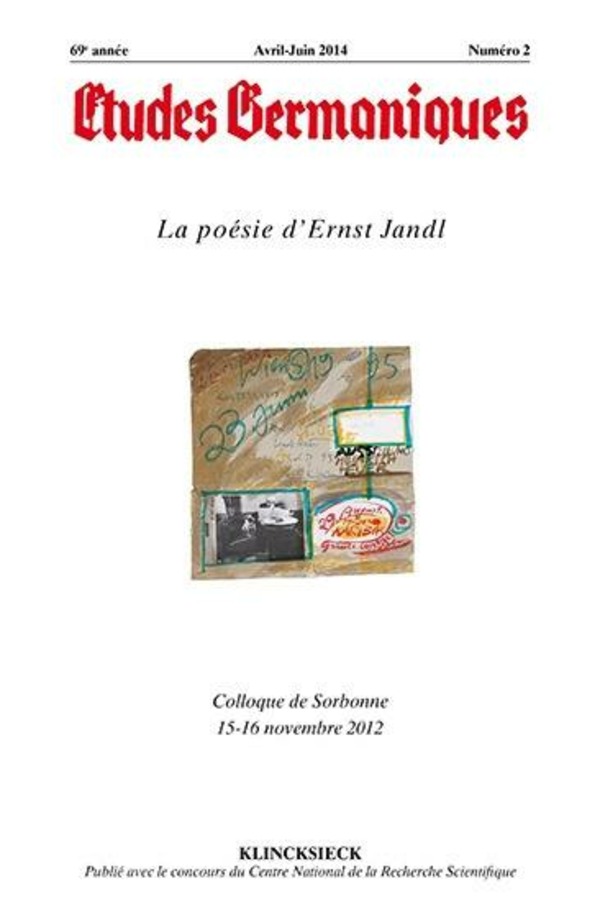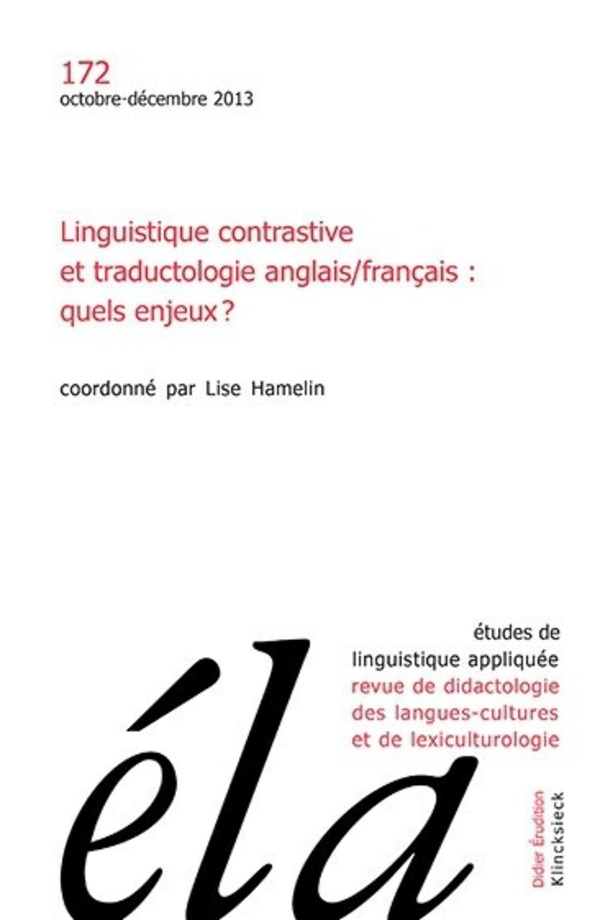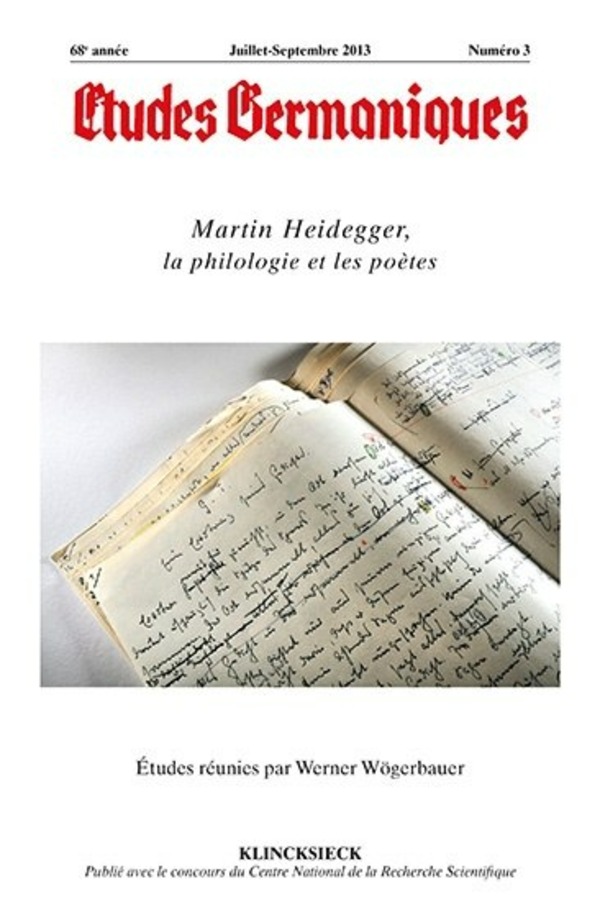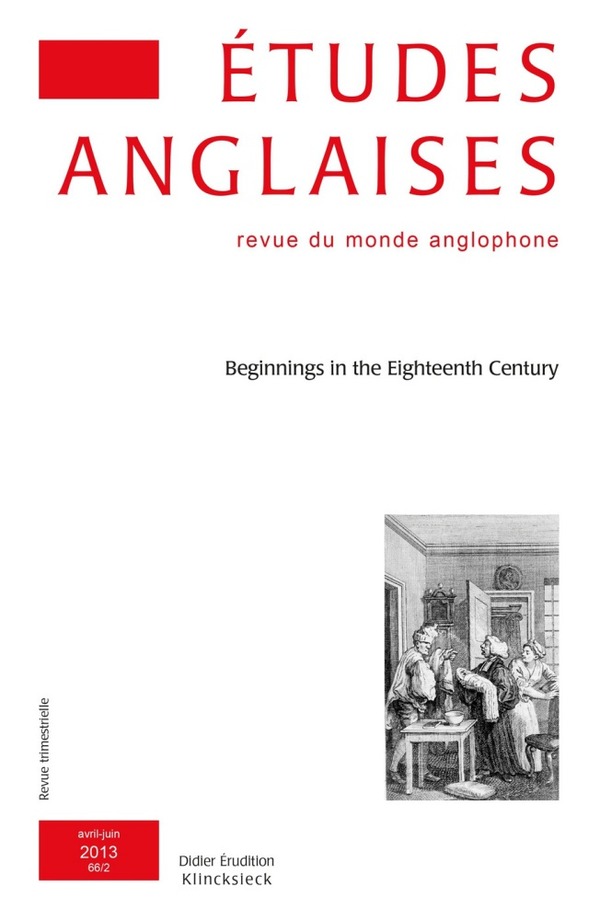Résultat de votre recherche : etudes chinoises

Études germaniques - N°2/2014
La poésie d'Ernst Jandl
RESUMES Laurent CASSAGNAU, Voir le corps de la langue, écouter la langue du corps. Ernst Jandl et la critique du logocentrisme.This article discusses the work of Ernst Jandl from the viewpoint of those twentieth century thinkers who challenge the idea of a transcendent logos, which pervades the Western tradition in...

Études anglaises - N°2/2014
Claire BOULARD-JOUSLIN : The making of public opinion in The Free-Thinker (1718-1721): from theory to practice Jean-Michel YVARD : « Oh you Materialist! » : oser publier On the Origin of Species Jason ALLEN : Le corps créole, fonction de la relation dans Drums and Colours de Derek Walcott Sandrine...

Études de linguistique appliquée - N°1/2014
Dialogue et dialogisme dans les textes en classe : approches pluridisciplinaires
Alain Rabatel : Empathie, points de vue, méta-représentation et dimension cognitive du dialogismeRésumé : Dans cet article, est dégagée l'importance du processus empathique, qui consiste à se mettre à la place des autres, à envisager leurs points de vue (PDV), aux plans psychologique, cognitif, méta-réflexif et linguistique. Ces PDV, envisageant...

Études germaniques - N°1/2014
Les classicismes, R. Wagner, S. George, F. Kafka, W. Herzog
René Sternke : Klassikentwürfe als Visionen zur Krisenbewältigung In order to for us to understand the motivation behind classical phenomena, three concepts of classicism are analyzed. Frederick II of Prussia proposes the vision of a German classicism in response to the absence of a German language and literature adequate to...

Études anglaises - N°1/2014
Claire VIAL : Clothing the debate: textiles, text-isles and the economy of gift-giving in four Middle English Breton lays Textiles, both as clothes and elements of the codified knightly costume, play a major structuring role in the Breton lays. Whether embodied in recurring poetic motives or staged in descriptive pauses,...

Études de linguistique appliquée - N°4/2013
Linguistique contrastive et traductologie anglais/français : quels enjeux ?
TRADUCTION DES ÉNONCÉS EN INCISE DU DISCOURS DIRECT : L'APPORT DE LA LINGUISTIQUE CONTRASTIVE Grâce aux travaux en linguistique contrastive développés par Jacqueline Guillemin-Flescher (entre autres Guillemin-Flescher 1981, 1984, 1993) et ses successeurs (voir les auteurs dans Contrastes, Gournay et Merle 2004), le cours de traduction, partout où il est...

Études anglaises - N°4/2013
Lives of the Poets
Jeremy ELPRIN"[T]he Life which was, as it were, already written": biographizing epistolary Keats If John Keats suspected he would be “among the English Poets” after his death, could he have imagined the multitude of biographical afterlives which would emerge from, and remain enveloped in, his private correspondence? In examining the...

Études germaniques - N°4/2013
Strindberg en héritage (Colloque de Paris BNF, 27-29 septembre 2012)
Gunnel ENGWALLStrindberg, journaliste français During his lifetime, August Strindberg participated not only in the Swedish newspaper debate but also in the French. The first contribution was published in 1883 and the last in 1911, with a concentration to the years 1885-1887 and 1894-1898, e.g. during Strindberg's longer stays in France....

Études de linguistique appliquée - N°3/2013
Parlers de métiers. Hommage à Gabrielle Quemada
HOMMAGE À GABRIELLE QUEMADA, LEXICOLOGUE ET PRÉFACIÈRE D'UN DICTIONNAIRE DU PARLER DES MÉTIERS DE PIERRE PERRET De son véritable titre Le Parler des métiers. Dictionnaire thématique alphabétique, l'ouvrage publié chez Laffont en 2002 qu'imagina et réalisa Pierre Perret, membre du Conseil su-périeur de la langue française lorsque cette institution était...

Études de linguistique appliquée - N°2/2013
Les dictionnaires bilingues et l'interculturel
Giovanni Tallarico : Les apports de la lexicographie bilingue à l'interculturel L'article aborde la question de l'interculturel dans les dictionnaires bilingues. Après avoir défini la notion d'interculturel, nous montrons la forte imbrication entre dictionnaires et contenus culturels, à travers un examen des realia, d'où émanent les écarts référentiels ; les...

Études anglaises - N°3/2013
Medieval objects
Stephanie A. Viereck Gibbs KAMATH : A cruel spoon in context: cutlery and conviviality in late medieval literature Indebted to Derek Brewer's "honor-group" theory, this essay explores how ideas of community and individuality found expression through depictions of spoon use in late medieval English and French texts. Guillaume de Digulleville's...

Études germaniques - N°3/2013
Martin Heidegger, la philologie et les poètes
Denis THOUARD : Voir dans les mots. L'herméneutique de la phénoménologie The article examines the development from a Heidegger-inspired phenomenology to an idiosyncratic kind of hermeneutics. It is shown that Heidegger clearly diverges from previous hermeneutics and splits up Dilthey's philosophical project : he radicalizes the analysis of understanding but...

Études anglaises - N°2/2013
Beginnings in the Eighteenth Century
Pierre LURBE : "Those Fabulous Dragons Teeth": invented beginnings, lost causes and new beginnings in John Toland's Amyntor (1699) In the late 1690s, the Irish maverick John Toland (1670-1722) played a crucial role in the publication of a number of Republican works of the mid-seventeenth century. His editorial task led...

Études germaniques - N°2/2013
(R) écritures du '17 juin 1953", Théâtre - Roman - Cinéma
Richard BLANCHET : Le 17 juin 1953 : stratégies filmiques et enjeux du film Zwei Tage Hoffnung de Peter Keglevic Peter Keglevic's movie Zwei Tage Hoffnung deals with the events of the 17th of June 1953, which are still differently interpreted by historians. His movie was intended to reach the...

Études de linguistique appliquée n°1/2013
Public Erasmus : vers une mobilité culturelle
Catherine Carlo : Les étudiants « Erasmus » saisis par l'Europe ? Résumé : Il y a une dizaine d'années, une enquête par entretiens avait été menée à l'Université Paris 8 (Carlo et Poisson-Quinton, 2001), auprès de 20 étudiants participant à un échange « Erasmus », notamment pour cerner les...
